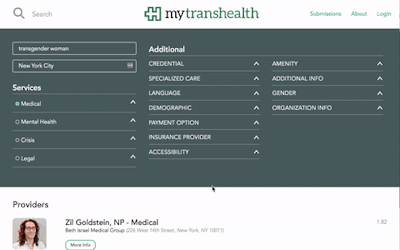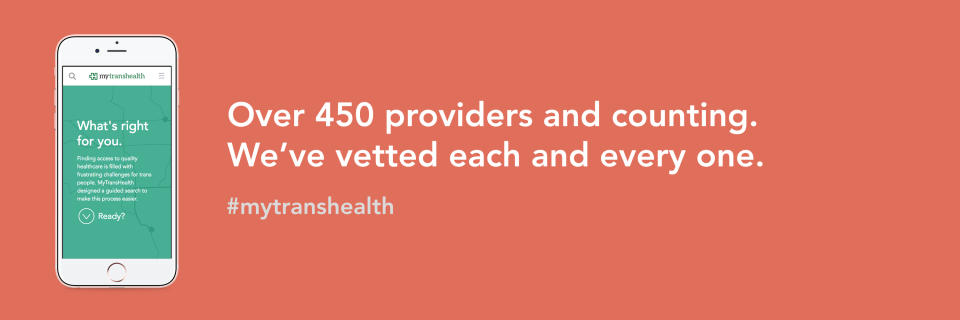This amazing startup helps trans and gender nonconforming people find quality health care
This amazing startup helps trans and gender nonconforming people find quality health care
MyTransHealth is a startup dedicated to the idea that access to quality health care is a human right. Seems obvious, right? However, trans and gender-nonconforming people often have a hard time accessing any health care at all, because doctors are often inexperienced with issues that affect the trans community, and can also be downright bigoted. That’s where MTH comes in — the team at MyTransHealth has been working hard to find providers who give quality care and have an understanding of the needs of trans and gender nonconforming people, and they’re adding new providers and working to serve new locations all the time.
We recently had the opportunity to speak to Kade Clark, the Founder and Executive Director of MyTransHealth, about the need for quality care for all, the team that built MTH, and the importance of self-care while building taking on such a project. Here’s our interview!
HelloGiggles (HG): Can you talk a little about the amazing team at MyTransHealth? How did you all get the idea, and how long did it take to develop?
Kade Clark (KC): The initial idea for MyTransHealth grew out of a personal experience. After moving to New York, I was referred to a local doctor at a reputable hospital for access to hormone replacement therapy. I was already six years into medical transition and very familiar with the requirements. I only needed a new prescription. Five minutes into the appointment it was very clear the doctor had never worked with a trans patient. When asked about their experience, they said, “I see trans people in the city all the time.” They prescribed the wrong medication, and I walked away from the office frustrated that I put my health in the hands of a doctor that wasn’t prepared to treat my needs. I shared my story with those in the community, and was met with no shock at all. Each of my peers had a similar, often worse, story of ignorance or discrimination. This had become an expected process — an understanding that we’re lucky to be treated at all.
That’s when I knew this had to change. I partnered with Amelia Gapin and Robyn Kanner to create MyTransHealth — a location-based website that connects the trans community with reliable, informed, respectful providers. After raising $30K in crowdsourced funding through Kickstarter in August of 2015, we worked with a small team of volunteers for 8 months to get the product off the ground.
Our amazing team at MyTransHealth understands the struggle for access to health care on a personal level, which allows us to make sure that the community remains our priority. Our mission is to change the status quo in healthcare for trans patients across the country.
HG: In the about page on the website, it says that “access to quality care is a human right,” and we couldn’t agree more. How would you talk about the specific need for MyTransHealth to someone who isn’t aware of discrimination transgender and gender nonconforming people face within the health care system?
KC: Like many marginalized groups, trans and gender nonconforming individuals face a wide array of discrimination and violence. In my experience, people tend to fear or “other” what they don’t understand, and media representation that sensationalizes trans stories can reinforce this behavior. There is an additional layer when discussing access to health care because there is no standardized education on how to treat and interact with the trans community. Often support staff may use the wrong name or pronouns in the waiting room, doctors may prescribe the wrong medication, or overlook an unrelated condition due to preoccupation with a person’s gender identity or genitals. The risk of discrimination and violence is always present and often disproportionately affects transgender people of color. The National Transgender Discrimination Survey (conducted by The National LGBTQ Taskforce) is a great reference for learning more.
HG: How do you find the providers you refer people to, and how are they screened to ensure quality care?
One of the first steps in building MyTransHealth was to elevate the existing resources in our community that were already doing the work on the ground. During the first months of research, we identified strong regional networks that were well vetted and shared between a small circle of providers and patients. The gap lies in the lack of virality with these lists. They often end up shelved on a site that doesn’t have the bandwidth to update them regularly, and are never seen by those who might need them most.
That’s where we come in. The MyTransHealth provider list is a mix of existing community organizations and user referrals. Currently, we feature providers and organizations across four areas of service: medical, mental health, legal and crisis care. We use a dynamic list of standards to vet referrals against before they go live. Questions we ask include: What percentage of their patient base identifies as transgender? Do they offer gender-affirming intake paperwork and bathrooms? Do they follow the WPATH Standards of Care or Informed Consent policies? Is their facility ADA compliant? Do they have documented continuing education credits in gender studies? Once a provider meets the requirements, they are featured. Each listing is re-vetted annually to ensure the best chance of accurate data.
HG: Speaking of care, how have you taken care of yourself during the development process? A project like this, while super important, is bound to be emotionally taxing. Do you have any self-care tips you’d like to share?
KC: I think our team learned this lesson the hard way! As a tech startup whose founders are personally invested in its success, we initially gave ourselves a very aggressive deadline. We knew the vital importance of this product, and wanted to bring it to the public as soon as possible. After hitting a few roadblocks along the way, we now understand the need to build in time for self-care and reflection. We intend for MyTransHealth to go the distance and in order to make that happen, we have to feel strong and empowered to keep going.
HG: Do you have any resources, besides MyTransHealth, that you’d like us to include with this interview that might be helpful? Either to spread information about why quality care is necessary for all people, or to help people find it?
KC: We encourage anyone who wants to learn more about the experiences of trans people to check out #transhealthfail on Twitter. Hundreds of community members have shared their stories, and helped our team bring these concerns to the public eye.
the only accessible psychologist i have has never heard of 'transgender'...#transhealthfail
— ケイティ (@katiecuon) April 20, 2016
#TransHealthFail Getting misgendered after correcting & your doc asking your dead name out of curiosity. How's this relevant to dermatology?
— Casey Hoke (@caseycreates) March 10, 2016
Told the doctor that I'm trans and he froze for a solid minute. Worst part about being trans is dealing with doctors #transhealthfail
— Clara H Tlalok (@plushqueenc) November 30, 2015
Did you think that was all? Not quite! Here’s a video from Co-founder and Chief Design Officer Robyn Kanner on her experience and the need for MyTransHealth.
The post This amazing startup helps trans and gender nonconforming people find quality health care appeared first on HelloGiggles.






